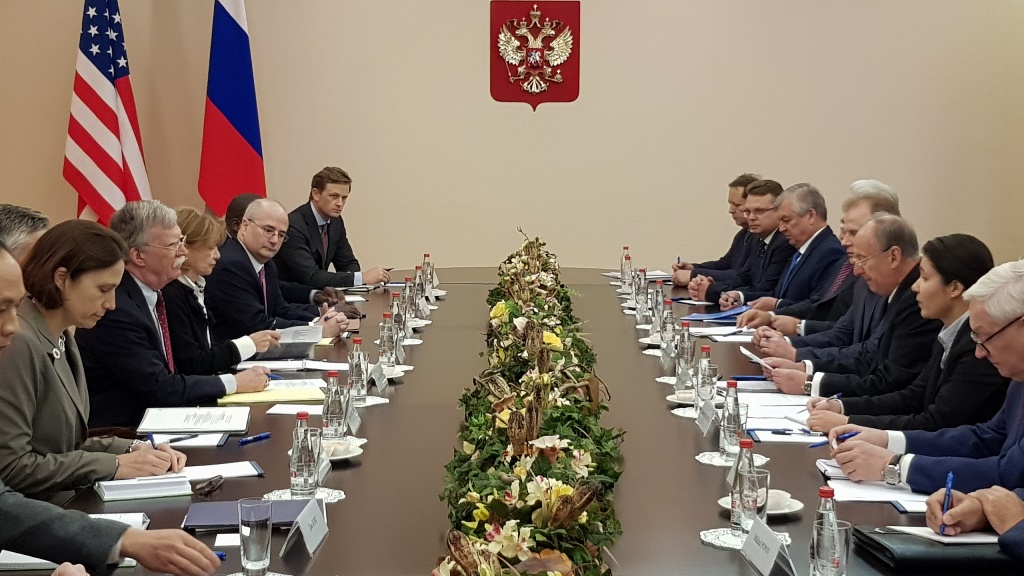NATO’s Stance in the INF Treaty Crisis

On 4 December, U.S. Secretary of State Mike Pompeo announced that if Russia does not return to compliance with the Intermediate-Range Nuclear Forces (INF) Treaty in 60 days, the U.S. will suspend its obligations under the agreement and withdraw at the end of the required six-month period. The treaty was signed in 1987 by the U.S. and USSR. It prohibits the possession, flight-testing, and production of ground-launched cruise missiles (GLCMs) and ground-launched ballistic missiles (GLBMs) with ranges between 500km and 5,500km, regardless of payload. Pompeo added that the while the treaty is being violated by Russia, it also hamstrings U.S. efforts to counter China and other countries not party to the INF and expanding such capabilities.
Pompeo’s reasoning is in line with remarks by President Donald Trump and his national security advisor, John Bolton, from October, when they announced the U.S. would withdraw from the treaty. The ultimatum, however, delays this exit in response to calls by NATO countries, some of which openly criticised Trump’s intentions (Germany and France, among others). Pompeo spoke during a meeting of foreign ministers of NATO members who for the first time agreed that Russia has violated the INF treaty. They stressed that the preservation of the accord depends on Russian actions.
Evolution of U.S. and NATO Positions
In 2014, the U.S. publicly accused Russia of flight-testing a prohibited GLCM (later identified as 9M729), and in 2017 informed that the missile was being deployed. Under the integrated strategy announced in December 2017, the U.S. continued diplomatic efforts to bring Russia back into compliance, in line with actions started by the Obama administration. But under Trump, the U.S. also imposed sanctions on companies developing the 9M729 and launched research and development (R&D) on conventional, INF-range ground-based systems (including a GLCM, as required by Congress). The treaty does not prohibit such R&D until it includes production or flight-testing of the missiles, which might take a couple of years. Thereby the U.S. signalled that it might leave the INF Treaty and deploy new missiles to Europe, but only as a last resort and in the longer term. Additionally, in line with the Nuclear Posture Review (NPR) report from February 2018, the U.S. began works on a nuclear sea-launched cruise missile, meant to be a bargaining chip regarding the INF but also broader reductions in Russia’s nuclear arsenal.
The announcement of the U.S. withdrawal from the INF marks a quick change in strategy. It is likely related to the growing influence of Bolton, who took office in March. For years, he has argued that the INF treaty unfairly constrains U.S. room for manoeuvre (although some American military officials and experts argue that INF treaty-compliant sea- and air-launched missiles are sufficient to counter China and other rivals). Meanwhile, the pressure on Russia was weakened by insufficient support from the other NATO members. They rarely raised the INF issue in public on their own. Joint NATO statements from 2014–2016 only generally noted the importance of the treaty and called on Russia to ensure full compliance. After being pressed by the U.S., NATO adopted a tougher stance only at the end of 2017. At the Brussels summit in July 2018, the Allies criticised Russia for a lack of constructive dialogue regarding 9M729 and concluded that it most likely violates the treaty. This implied that doubts about the accuracy of U.S. intelligence persisted until the December meeting. The inertia of many Allies also seemed to follow from fears that too strong of support for the U.S. would encourage an American military response, which in turn would result in an escalation of tensions with Russia and negative public reception.
Consequences of the Demise of the INF Treaty for NATO
If the INF treaty collapses, Russia will be able to openly expand its stock of the previously banned capabilities, including the deployment of additional 9M729 missiles. These missiles are most likely capable of delivering both nuclear and conventional warheads. They are based on ground-mobile launchers, which are cheaper than aircraft, ships, and submarines not covered by the treaty. Ground platforms are also not assigned to other tasks and can be permanently kept within the range of their targets. A large number of such systems would, first of all, enhance the Russian capabilities for swift conventional strikes, especially against targets in Western Europe, such as the infrastructure necessary for the deployment of reinforcements to NATO’s Eastern Flank. Although Russia already possesses diverse capabilities for nuclear strikes against Europe, it cannot be excluded that it will also use 9M729 missiles or other INF systems to intimidate European NATO members. Limiting the risk of short-notice nuclear attacks was precisely the original goal of the INF treaty. To this day, there are pacifist (antinuclear) sentiments in Western Europe that date back to the 1980s and the mass public protests against the deployment of U.S. GLBMs and GLCMs to counter Soviet SS-20 missiles. Among this group are countries that host U.S. B61 nuclear bombs and are either conducting or considering modernisation of dual-capable aircraft assigned for their delivery (including Germany and the Netherlands). They perceive NATO’s commitment to arms control as a condition for their support for Allied nuclear deterrence policy. The U.S. withdrawal from the INF treaty might complicate the maintenance of this consensus.
Strengthening NATO’s position on the INF is a substantial achievement given the differences within the Alliance. These differences are, however, still present, especially as the U.S. still envisages withdrawal from the treaty. The original announcement from Trump had not been consulted in NATO and increased transatlantic tensions and concerns about the U.S. willingness to enhance its military posture in Asia at Europe’s expense. This issue will be used as an argument for greater European autonomy in defence, as the French president already has. The German foreign ministry called for Europe to play a greater role in the global discussion on arms control. Although the desire to preserve the INF treaty brings the NATO allies together, some of them (including Poland and the UK) expressed understanding for the Trump administration’s announcement, citing Russian violations. Therefore, a further response to the Russian breach of the INF will be subject to difficult discussions in NATO.
Perspectives
NATO’s latest statement and the U.S. ultimatum will allow them to clearly communicate to the public and international community that Russia is to blame for the demise of the INF treaty. The latter is almost certain. Nothing suggests that Russia sees any interest in saving the agreement. Russia sought to abolish the treaty or extend the number of parties already in the late 2000s, and, according to the U.S., it began violating the INF at the same time. For years, it has been denying its violations and has not been transparent (for example, it had denied the existence of the 9M729 missile until the U.S. identified its name publicly). It also has tried to put the blame on the U.S. through counter-accusations. These include allegations that the American missile-defence site in Romania has offensive capability and violates the INF, as will a similar site under construction in Redzikowo, Poland. NATO wholly rejects these claims.
Therefore, there is no real chance that the Russian calculations will change with the intensified diplomatic efforts some NATO members are likely to undertake. The sole prospect of the U.S. withdrawal from the INF treaty is also unlikely to have an impact. In October, U.S. officials stated there currently are no plans to deploy INF missiles in Europe. There is also no NATO consensus on this issue, or on any other military response to the Russian violation. The latest joint statement notes solely that the Allies will continue to review the fielding of Russian INF systems and to ensure the credibility and effectiveness of NATO’s overall deterrence and defence posture. At the same time, bilateral attempts to deploy American missiles in Europe would inflame tensions within the Alliance, and Russia would try to exploit them.
Nonetheless, the Allies should use the time before the U.S. notifies and concludes its withdrawal to consult a joint NATO position on the future of the arms-control regime. The talks should include consideration of ways to punish Russia for its violation of the INF. Such measures would be important to dissuade Russia from breaching potential future agreements.





